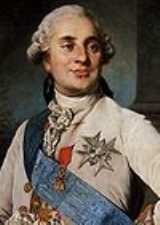
Legitimists
Encyclopedia

Monarchism
Monarchism is the advocacy of the establishment, preservation, or restoration of a monarchy as a form of government in a nation. A monarchist is an individual who supports this form of government out of principle, independent from the person, the Monarch.In this system, the Monarch may be the...
in France who adhere to the rights of dynastic succession of the descendants of the elder branch of the Bourbon
House of Bourbon
The House of Bourbon is a European royal house, a branch of the Capetian dynasty . Bourbon kings first ruled Navarre and France in the 16th century. By the 18th century, members of the Bourbon dynasty also held thrones in Spain, Naples, Sicily, and Parma...
dynasty, which was overthrown in the 1830 July Revolution. They reject the claim of the July Monarchy
July Monarchy
The July Monarchy , officially the Kingdom of France , was a period of liberal constitutional monarchy in France under King Louis-Philippe starting with the July Revolution of 1830 and ending with the Revolution of 1848...
of 1830–1848, whose kings were members of the junior Orléans
House of Orleans
Orléans is the name used by several branches of the Royal House of France, all descended in the legitimate male line from the dynasty's founder, Hugh Capet. It became a tradition during France's ancien régime for the duchy of Orléans to be granted as an appanage to a younger son of the king...
line of the Bourbon dynasty. Following the movement of Ultra-royalists during the Bourbon Restoration
Bourbon Restoration
The Bourbon Restoration is the name given to the period following the successive events of the French Revolution , the end of the First Republic , and then the forcible end of the First French Empire under Napoleon – when a coalition of European powers restored by arms the monarchy to the...
of 1814, legitimists came to form one of the three main right-wing factions in France, which was principally characterized by its counterrevolutionary
Counterrevolutionary
A counter-revolutionary is anyone who opposes a revolution, particularly those who act after a revolution to try to overturn or reverse it, in full or in part...
views (they rejected the 1789 French Revolution
French Revolution
The French Revolution , sometimes distinguished as the 'Great French Revolution' , was a period of radical social and political upheaval in France and Europe. The absolute monarchy that had ruled France for centuries collapsed in three years...
, the Republic and everything that went with it; thus, they progressively became a far-right movement, close to traditionalist Catholic
Traditionalist Catholic
Traditionalist Catholics are Roman Catholics who believe that there should be a restoration of many or all of the liturgical forms, public and private devotions and presentations of Catholic teachings which prevailed in the Catholic Church before the Second Vatican Council...
s). The other two right-wing factions are, according to historian René Rémond
René Rémond
-Biography:Born in Lons-le-Saunier, Rémond was the Secretary General of Jeunesses étudiantes Catholiques and a member of the International YCS Center of Documentation and Information in Paris, presently the International Secretariat of International Young Catholic Students The author of books on...
, the Orleanist
Orléanist
The Orléanists were a French right-wing/center-right party which arose out of the French Revolution. It governed France 1830-1848 in the "July Monarchy" of king Louis Philippe. It is generally seen as a transitional period dominated by the bourgeoisie and the conservative Orleanist doctrine in...
s and the Bonapartist
Bonapartist
In French political history, Bonapartism has two meanings. In a strict sense, this term refers to people who aimed to restore the French Empire under the House of Bonaparte, the Corsican family of Napoleon Bonaparte and his nephew Louis...
s.
Legitimists hold that the king of France must be chosen according to the traditional rules of succession based in the Salic Law
Salic law
Salic law was a body of traditional law codified for governing the Salian Franks in the early Middle Ages during the reign of King Clovis I in the 6th century...
. With the direct line of Charles X having become extinct in 1883 with the death of his grandson Henry, Count of Chambord, present-day legitimists also reject the succession by subsequent members of the Orleans branch, arguing that members of the Spanish branch of the Bourbons descending from Philip V of Spain
Philip V of Spain
Philip V was King of Spain from 15 November 1700 to 15 January 1724, when he abdicated in favor of his son Louis, and from 6 September 1724, when he assumed the throne again upon his son's death, to his death.Before his reign, Philip occupied an exalted place in the royal family of France as a...
possess a more senior claim.
The Bourbon Restoration (1814–1830)
Following the Bourbon RestorationBourbon Restoration
The Bourbon Restoration is the name given to the period following the successive events of the French Revolution , the end of the First Republic , and then the forcible end of the First French Empire under Napoleon – when a coalition of European powers restored by arms the monarchy to the...
in 1814, a strongly restricted census suffrage sent to the Chamber of Deputies
Chamber of Deputies
Chamber of deputies is the name given to a legislative body such as the lower house of a bicameral legislature, or can refer to a unicameral legislature.-Description:...
an ultra-royalist
Ultra-royalist
Ultra-Royalists or simply Ultras were a reactionary faction which sat in the French parliament from 1815 to 1830 under the Bourbon Restoration...
majority in 1815–1816 (la Chambre introuvable
Chambre introuvable
La Chambre introuvable was the first Chamber of Deputies elected after the Second Bourbon Restoration in 1815. It was dominated by Ultra-royalists who completely refused to accept the results of the French Revolution...
) and from 1824 to 1827. Called as such because they were "more royalist than the king
King
- Centers of population :* King, Ontario, CanadaIn USA:* King, Indiana* King, North Carolina* King, Lincoln County, Wisconsin* King, Waupaca County, Wisconsin* King County, Washington- Moving-image works :Television:...
" (plus royalistes que le roi), the Ultras were thus the dominant political faction under Louis XVIII (1815–1824) and Charles X
Charles X of France
Charles X was known for most of his life as the Comte d'Artois before he reigned as King of France and of Navarre from 16 September 1824 until 2 August 1830. A younger brother to Kings Louis XVI and Louis XVIII, he supported the latter in exile and eventually succeeded him...
(1824–1830). Opposed to the constitutional monarchy
Constitutional monarchy
Constitutional monarchy is a form of government in which a monarch acts as head of state within the parameters of a constitution, whether it be a written, uncodified or blended constitution...
of Louis XVIII and to the limitation of the sovereign
Sovereignty
Sovereignty is the quality of having supreme, independent authority over a geographic area, such as a territory. It can be found in a power to rule and make law that rests on a political fact for which no purely legal explanation can be provided...
's power, they hoped to restore the Ancien Régime and cancel the rupture created by the French Revolution
French Revolution
The French Revolution , sometimes distinguished as the 'Great French Revolution' , was a period of radical social and political upheaval in France and Europe. The absolute monarchy that had ruled France for centuries collapsed in three years...
. By the same token, Ultras opposed all liberal
Liberalism
Liberalism is the belief in the importance of liberty and equal rights. Liberals espouse a wide array of views depending on their understanding of these principles, but generally, liberals support ideas such as constitutionalism, liberal democracy, free and fair elections, human rights,...
, republican
Republicanism
Republicanism is the ideology of governing a nation as a republic, where the head of state is appointed by means other than heredity, often elections. The exact meaning of republicanism varies depending on the cultural and historical context...
and democratic
Democracy
Democracy is generally defined as a form of government in which all adult citizens have an equal say in the decisions that affect their lives. Ideally, this includes equal participation in the proposal, development and passage of legislation into law...
ideas. While Louis XVIII hoped to moderate the "restoration" of the Ancien Régime in order to make it acceptable to the population, the Ultras would never abandon the dream of an integral restoration, even after the 1830 July Revolution
July Revolution
The French Revolution of 1830, also known as the July Revolution or in French, saw the overthrow of King Charles X of France, the French Bourbon monarch, and the ascent of his cousin Louis-Philippe, Duke of Orléans, who himself, after 18 precarious years on the throne, would in turn be overthrown...
which set the Orleanist
Orléanist
The Orléanists were a French right-wing/center-right party which arose out of the French Revolution. It governed France 1830-1848 in the "July Monarchy" of king Louis Philippe. It is generally seen as a transitional period dominated by the bourgeoisie and the conservative Orleanist doctrine in...
branch on the throne and the Ultras back to their castles in the countryside and to private life. Their importance during the Restoration was in part due to electoral laws which largely favored them (on one hand, a Chamber of Peers composed of hereditary members; on the other hand, a Chamber of Deputies elected under a heavily restricted census suffrage, which permitted approximately 100,000 Frenchmen to vote).
Louis XVIII's first ministers, who included Talleyrand, the duc de Richelieu
Armand-Emmanuel du Plessis, Duc de Richelieu
Armand Emmanuel Sophie Septimanie de Vignerot du Plessis, 5th Duke of Richelieu was a prominent French statesman during the Bourbon Restoration...
and Decazes
Élie, duc Decazes
Élie Decazes, 1st duc Decazes and 1st Duke of Glücksbierg , was a French statesman, known from 1815 to 1820 as 1st comte Decazes in France, 1st Duke of Glücksbierg in Denmark in 1818, and 1st duc Decazes in France in 1820 .-Early life:Élie Decazes was born at Saint-Martin-de-Laye, Gironde, son of...
, were replaced by the Chambre introuvable dominated by the Ultras. Louis XVIII finally decided to dissolve this chaotic assembly, but the new liberals who replaced them were no easier to govern. After the 1820 assassination of the duc de Berry
Charles Ferdinand, duc de Berry
Charles Ferdinand d'Artois, Duke of Berry was the younger son of the future king, Charles X of France, and his wife, Princess Maria Theresa of Savoy....
, the ultra-reactionary
Reactionary
The term reactionary refers to viewpoints that seek to return to a previous state in a society. The term is meant to describe one end of a political spectrum whose opposite pole is "radical". While it has not been generally considered a term of praise it has been adopted as a self-description by...
son of the comte d'Artois (Louis XVIII's brother and future Charles X), and a short interval during which the duc de Richelieu governed, the Ultras were back in government, headed by the comte de Villèle
Jean-Baptiste Guillaume Joseph, comte de Villèle
Jean-Baptiste Guillaume Joseph Marie Anne Séraphin, comte de Villèle , was a French statesman. Several time Prime minister, he was a leader of the Ultra-royalist faction during the Bourbon Restoration.- Youth :...
.
The death in 1824 of the moderate Louis XVIII emboldened the Ultra faction. In January 1825, Villèle's government passed the Anti-Sacrilege Act
Anti-Sacrilege Act
The Anti-Sacrilege Act was a French law against blasphemy and sacrilege passed in January 1825 under King Charles X. The law was never applied and was later revoked at the beginning of the July monarchy under King Louis-Philippe.-The draft bill:In April 1824, King Louis XVIII's government, headed...
, which punished by death
Capital punishment
Capital punishment, the death penalty, or execution is the sentence of death upon a person by the state as a punishment for an offence. Crimes that can result in a death penalty are known as capital crimes or capital offences. The term capital originates from the Latin capitalis, literally...
the theft of sacred vessels (with or without consecrated hosts). This "anachronistic law" (Jean-Noël Jeanneney
Jean-Noël Jeanneney
Jean-Noël Jeanneney is a French historian and politician, born on 2 April 1942 in Grenoble. He is the son of Jean-Marcel Jeanneney and the grandson of Jules Jeanneney, both important figures in French politics.-Education:...
) was in the end never applied (except on a minor point) and repealed in the first months of Louis Philippe I's reign (1830–1848). The Ultras also wanted to create courts to punish Radicals
Radicalization
Radicalization is the process in which an individual changes from passiveness or activism to become more revolutionary, militant or extremist. Radicalization is often associated with youth, adversity, alienation, social exclusion, poverty, or the perception of injustice to self or others.-...
, and passed laws restricting freedom of the press
Freedom of the press
Freedom of the press or freedom of the media is the freedom of communication and expression through vehicles including various electronic media and published materials...
.
After the 1830 July Revolution
July Revolution
The French Revolution of 1830, also known as the July Revolution or in French, saw the overthrow of King Charles X of France, the French Bourbon monarch, and the ascent of his cousin Louis-Philippe, Duke of Orléans, who himself, after 18 precarious years on the throne, would in turn be overthrown...
replaced the Bourbons with the more liberal Orleanist
Orléanist
The Orléanists were a French right-wing/center-right party which arose out of the French Revolution. It governed France 1830-1848 in the "July Monarchy" of king Louis Philippe. It is generally seen as a transitional period dominated by the bourgeoisie and the conservative Orleanist doctrine in...
branch, the Ultras' influence declined, although it survived until at least the 16 May 1877 crisis
16 May 1877 crisis
The 16 May 1877 crisis was a constitutional crisis in the French Third Republic concerning the distribution of power between the President and the legislature. When the Royalist President Patrice MacMahon dismissed the Opportunist Republican Prime Minister Jules Simon, parliament on 16 May 1877...
and 1879, and even longer. They softened their views and made the restoration of the House of Bourbon
House of Bourbon
The House of Bourbon is a European royal house, a branch of the Capetian dynasty . Bourbon kings first ruled Navarre and France in the 16th century. By the 18th century, members of the Bourbon dynasty also held thrones in Spain, Naples, Sicily, and Parma...
their main aim. From 1830 on they became known as Legitimists.
Legitimists under the July Monarchy (1830–1848)
During the July MonarchyJuly Monarchy
The July Monarchy , officially the Kingdom of France , was a period of liberal constitutional monarchy in France under King Louis-Philippe starting with the July Revolution of 1830 and ending with the Revolution of 1848...
of 1830 to 1848, when the junior Orleanist
House of Orleans
Orléans is the name used by several branches of the Royal House of France, all descended in the legitimate male line from the dynasty's founder, Hugh Capet. It became a tradition during France's ancien régime for the duchy of Orléans to be granted as an appanage to a younger son of the king...
branch held the throne, the Legitimists were politically marginalized
Marginalization
In sociology, marginalisation , or marginalization , is the social process of becoming or being made marginal or relegated to the fringe of society e.g.; "the marginalization of the underclass", "marginalisation of intellect", etc.-Individual:Marginalization at the individual level results in an...
, many withdrawing from active participation in political life. The situation was complicated before 1844 by debate as to who the legitimate king
Monarch
A monarch is the person who heads a monarchy. This is a form of government in which a state or polity is ruled or controlled by an individual who typically inherits the throne by birth and occasionally rules for life or until abdication...
was: Charles X
Charles X of France
Charles X was known for most of his life as the Comte d'Artois before he reigned as King of France and of Navarre from 16 September 1824 until 2 August 1830. A younger brother to Kings Louis XVI and Louis XVIII, he supported the latter in exile and eventually succeeded him...
and his son Louis-Antoine the Dauphin
Louis-Antoine, Duke of Angouleme
Louis Antoine of France, Duke of Angoulême was the eldest son of Charles X of France and, from 1824 to 1836, the last Dauphin of France...
had both abdicated during the 1830 Revolution in favor of Charles's young grandson, Henri comte de Chambord. Until the deaths of Charles X and his son in 1836 and 1844, respectively, many Legitimists continued to recognize each of them in turn as the rightful king, ahead of Chambord.
Legitimists under the Second Republic and the Second Empire (1848–1871)
The fall of King Louis Philippe I in 1848 led to a strengthening of the Legitimist position. Although the childlessness of Chambord weakened the hand of the Legitimists, they came back into political prominence during the Second Republic. Legitimists joined with Orleanists to form the Party of Order which dominated parliament from the elections of May 1849 until Bonaparte's coup on December 2, 1851. They formed a prominent part of Odilon BarrotOdilon Barrot
Camille Hyacinthe Odilon Barrot was a French politician.-Early life:Barrot was born at Villefort Lozère. He belonged to a legal family, his father, an advocate of Toulouse, having been a member of the Convention who had voted against the death of Louis XVI. Odilon Barrot's earliest recollections...
's ministry from December 1848 to November 1849, and in 1850 were successful in passing the Falloux
Frédéric Alfred Pierre, comte de Falloux
Frédéric-Alfred-Pierre, comte de Falloux was a French politician and author, famous for having given his name to two laws on education, favorizing private Catholic teaching.-Life:He was born at Angers, Maine-et-Loire...
Law which brought the Catholic Church back into secondary education.
Through much of this time there was discussion of "fusion" with the Orleanist
Orléanist
The Orléanists were a French right-wing/center-right party which arose out of the French Revolution. It governed France 1830-1848 in the "July Monarchy" of king Louis Philippe. It is generally seen as a transitional period dominated by the bourgeoisie and the conservative Orleanist doctrine in...
Party so that the two could effect a monarchical restoration. This prospect prompted several sons
House of Orleans
Orléans is the name used by several branches of the Royal House of France, all descended in the legitimate male line from the dynasty's founder, Hugh Capet. It became a tradition during France's ancien régime for the duchy of Orléans to be granted as an appanage to a younger son of the king...
of Louis Philippe to declare their support for Chambord. But fusion was not actually achieved, and after 1850 the two parties again diverged. The most committed Orleanists supported the candidacy of Louis Philippe's third son, the Prince de Joinville, for the presidency, while the legitimists largely supported allowing Bonaparte to run for a second term. In spite of this support for Bonaparte's ambitions, they opposed his scheme to restore universal suffrage in the last months of 1851, and their leaders were, like those of the Orleanists, arrested during Bonaparte's coup.
The period of the Second Empire
Second French Empire
The Second French Empire or French Empire was the Imperial Bonapartist regime of Napoleon III from 1852 to 1870, between the Second Republic and the Third Republic, in France.-Rule of Napoleon III:...
saw the Legitimists once again cast out of active political life.
Legitimists under the Third Republic (1871–1940)
Nevertheless, the Legitimists remained a significant party within eliteElite
Elite refers to an exceptional or privileged group that wields considerable power within its sphere of influence...
opinion, attracting support of the larger part of the ancien régime aristocracy. After the Siege of Paris
Siege of Paris
The Siege of Paris, lasting from September 19, 1870 – January 28, 1871, and the consequent capture of the city by Prussian forces led to French defeat in the Franco-Prussian War and the establishment of the German Empire as well as the Paris Commune....
in 1870 and the 1871 Paris Commune
Paris Commune
The Paris Commune was a government that briefly ruled Paris from March 18 to May 28, 1871. It existed before the split between anarchists and Marxists had taken place, and it is hailed by both groups as the first assumption of power by the working class during the Industrial Revolution...
, the Legitimists returned for one final time to political prominence. The 8 February 1871 elections, held under universal manhood suffrage
Universal suffrage
Universal suffrage consists of the extension of the right to vote to adult citizens as a whole, though it may also mean extending said right to minors and non-citizens...
, gave the National Assembly
National Assembly
National Assembly is either a legislature, or the lower house of a bicameral legislature in some countries. The best known National Assembly, and the first legislature to be known by this title, was that established during the French Revolution in 1789, known as the Assemblée nationale...
a royalist majority supported by the provinces, while all the Parisian deputies were Republican
Republicanism
Republicanism is the ideology of governing a nation as a republic, where the head of state is appointed by means other than heredity, often elections. The exact meaning of republicanism varies depending on the cultural and historical context...
. This time, the Legitimists were able to agree with the Orleanists on a program of fusion, largely because of the growing likelihood that the count of Chambord would die without children. The liberal Orleanists agreed to recognize Chambord as king, and the Orleanist claimant himself, Louis-Philippe Albert d'Orléans
Philippe, Comte de Paris
Philippe d'Orléans, Count of Paris was the grandson of Louis Philippe I, King of the French. He was a claimant to the French throne from 1848 until his death.-Early life:...
(1838–1894), count of Paris, recognized Chambord as head of the French royal house. In return, Legitimists in the Assembly agreed that, should Chambord die childless, Philippe d'Orléans would succeed him as king. Unfortunately for French monarchism, Chambord's refusal to accept the Tricolor
Tricolor
Tricolor or tricolor may refer to something with three colors :* Tricolour flag, any flag or banner having three colours, particularly in bands of approximately equal width** Tricolour, the flag of France, commonly called the Tricolour in English...
as the flag of France and to abandon the fleur-de-lys, symbol of the Ancien régime, made restoration impossible until after his death in 1883, by which time the monarchists had long since lost their parliamentary majority due to the 16 May 1877 crisis
16 May 1877 crisis
The 16 May 1877 crisis was a constitutional crisis in the French Third Republic concerning the distribution of power between the President and the legislature. When the Royalist President Patrice MacMahon dismissed the Opportunist Republican Prime Minister Jules Simon, parliament on 16 May 1877...
. The death of Chambord effectively dissolved the parti légitimiste as a political force in France.
Affected by sinistrisme
Sinistrisme
Sinistrisme is a neologism invented by Albert Thibaudet in Les idées politiques de la France . He referred to the progressive substitution of left wing parties by new, more radical parties, which in turn pushed each party towards the center Sinistrisme is a neologism invented by Albert Thibaudet in...
, few conservatives explicitly called themselves right wing during the Third Republic: it became a term associated with the Counter-Revolution and anti-republican feelings, and by the 1900s was reserved for radical groups. Those Legitimists who had rallied to the Republic in 1893, after the comte de Chambord's death ten years before, still called themselves Droite constitutionnelle or républicaine (Constitutional or Republican Right). But they changed their name in 1899, and entered the 1902 elections under the name Action libérale. By 1910, the only group which openly claimed descent from the right wing gathered only nostalgic royalists, and from 1924 on the term "right wing" practically vanished from the parliamentary right's glossary.
By this time, the vast majority of legitimists had retired to their country chateaux and abandoned the political arena. Although the Action française remained an influential movement throughout the 1930s, its motivations for the restoration
Restauration
Restauration is French for restoration.Restauration can refer to:*European Restoration, the return of many monarchies after Napoleon's French were defeated.** Bourbon Restoration, the restoration of the French monarchy under Louis XVIII....
of monarchy were quite distinct from older Legitimists' views, and Maurras' instrumental use of Catholicism set them at odds. Thus, Legitimists participated little in the political events of the 1920s and 30s, in particular in the 6 February 1934 riots organized by far right
Far right
Far-right, extreme right, hard right, radical right, and ultra-right are terms used to discuss the qualitative or quantitative position a group or person occupies within right-wing politics. Far-right politics may involve anti-immigration and anti-integration stances towards groups that are...
leagues. The royalist aristocrat
Aristocracy (class)
The aristocracy are people considered to be in the highest social class in a society which has or once had a political system of Aristocracy. Aristocrats possess hereditary titles granted by a monarch, which once granted them feudal or legal privileges, or deriving, as in Ancient Greece and India,...
s clearly distinguished themselves from the new ultra right, influenced by the emerging movements of fascism
Fascism
Fascism is a radical authoritarian nationalist political ideology. Fascists seek to rejuvenate their nation based on commitment to the national community as an organic entity, in which individuals are bound together in national identity by suprapersonal connections of ancestry, culture, and blood...
and nazism
Nazism
Nazism, the common short form name of National Socialism was the ideology and practice of the Nazi Party and of Nazi Germany...
. However, Legitimists joined Maurras in celebrating the fall of the Third Republic after the 1940 Battle of France
Battle of France
In the Second World War, the Battle of France was the German invasion of France and the Low Countries, beginning on 10 May 1940, which ended the Phoney War. The battle consisted of two main operations. In the first, Fall Gelb , German armoured units pushed through the Ardennes, to cut off and...
as a "divine surprise", and many of them entered Pétain
Philippe Pétain
Henri Philippe Benoni Omer Joseph Pétain , generally known as Philippe Pétain or Marshal Pétain , was a French general who reached the distinction of Marshal of France, and was later Chief of State of Vichy France , from 1940 to 1944...
's Vichy administration as a golden opportunity to impose a reactionary program in occupied France.
Legitimists under Vichy and after World War II (1940–Present)
Legitimists returned to prominence during Vichy FranceVichy France
Vichy France, Vichy Regime, or Vichy Government, are common terms used to describe the government of France that collaborated with the Axis powers from July 1940 to August 1944. This government succeeded the Third Republic and preceded the Provisional Government of the French Republic...
, according to historian René Rémond
René Rémond
-Biography:Born in Lons-le-Saunier, Rémond was the Secretary General of Jeunesses étudiantes Catholiques and a member of the International YCS Center of Documentation and Information in Paris, presently the International Secretariat of International Young Catholic Students The author of books on...
's studies of the right-wing factions in France. Some would also support the OAS during the Algerian War (1954–62). Marcel Lefebvre
Marcel Lefebvre
Marcel François Marie Joseph Lefebvre was a French Roman Catholic archbishop. Following a career as an Apostolic Delegate for West Africa and Superior General of the Holy Ghost Fathers, he took the lead in opposing the changes within the Church associated with the Second Vatican Council.In 1970,...
's Society of St. Pius X
Society of St. Pius X
The Society of Saint Pius X is an international Traditionalist Catholic organisation, founded in 1970 by the French archbishop Marcel Lefebvre...
, founded in 1970, especially in France, shares aspects with the legitimist movement, according to Rémond.
As of 2006, some remain strongly attached to the tradition
Tradition
A tradition is a ritual, belief or object passed down within a society, still maintained in the present, with origins in the past. Common examples include holidays or impractical but socially meaningful clothes , but the idea has also been applied to social norms such as greetings...
alist wing of the Catholic Church and are particularly encouraged by the theological
Theology
Theology is the systematic and rational study of religion and its influences and of the nature of religious truths, or the learned profession acquired by completing specialized training in religious studies, usually at a university or school of divinity or seminary.-Definition:Augustine of Hippo...
conservatism of Pope Benedict XVI. Such Legitimists are strongly opposed to the proposed European Constitution and anything else perceived as threatening the independence of France. Among French Legitimists, there is diversity of opinion. Some tend to gather around Traditionalist Catholic
Traditionalist Catholic
Traditionalist Catholics are Roman Catholics who believe that there should be a restoration of many or all of the liturgical forms, public and private devotions and presentations of Catholic teachings which prevailed in the Catholic Church before the Second Vatican Council...
places, such as the Saint-Nicolas-du-Chardonnet
Saint-Nicolas-du-Chardonnet
Saint-Nicolas-du-Chardonnet is a Roman Catholic church in the centre of Paris, France located in the 5th arrondissement. In 1977 it was occupied by traditionalist Society of St...
church in Paris, or around far-right parties such as Jean-Marie Le Pen
Jean-Marie Le Pen
Jean-Marie Le Pen is a French far right-wing and nationalist politician who is founder and former president of the Front National party. Le Pen has run for the French presidency five times, most notably in 2002, when in a surprise upset he came second, polling more votes in the first round than...
's Front National or de Villiers
De Villiers
de Villiers may refer to:*AB de Villiers, a current South African international cricketer*De Villiers Graaff, a former South African politician.*Fanie de Villiers, a former South African cricketer...
' Mouvement pour la France. Many others are true democrats, wishing France could have a parliamentary monarchy like the ones of the United Kingdom or Spain. There are small but active Legitimist circles throughout France.
After Chambord's death, only the descendants of Philip V of Spain
Philip V of Spain
Philip V was King of Spain from 15 November 1700 to 15 January 1724, when he abdicated in favor of his son Louis, and from 6 September 1724, when he assumed the throne again upon his son's death, to his death.Before his reign, Philip occupied an exalted place in the royal family of France as a...
remained senior in descent to the Orléans branch of the royal dynasty. But Philip's branch had been Spanish for 170 years, having been obliged by the 1713 Treaty of Utrecht
Treaty of Utrecht
The Treaty of Utrecht, which established the Peace of Utrecht, comprises a series of individual peace treaties, rather than a single document, signed by the belligerents in the War of Spanish Succession, in the Dutch city of Utrecht in March and April 1713...
to renounce their claim to the French throne. Some French royalists believed the Count of Paris to be the legitimate pretender, while others uphold the rights of the senior line in the person of the Duke of Anjou.
Carlism
A remnant, known as the blancs d'Espagne ("Whites of Spain"), by repudiating Philip V's renunciation of the French throne as ultra viresUltra vires
Ultra vires is a Latin phrase meaning literally "beyond the powers", although its standard legal translation and substitute is "beyond power". If an act requires legal authority and it is done with such authority, it is...
and contrary to the Fundamental French monarchical law, upheld the rights of the eldest branch of the Bourbons, represented as of 1883 by the Carlist
Carlism
Carlism is a traditionalist and legitimist political movement in Spain seeking the establishment of a separate line of the Bourbon family on the Spanish throne. This line descended from Infante Carlos, Count of Molina , and was founded due to dispute over the succession laws and widespread...
pretender to the Spanish throne. This group was initially minuscule, but began to grow larger after World War II due both to the political leftism of the Orleanist Pretender, Henri, comte de Paris
Henri, comte de Paris
Henri of Orléans, Count of Paris , was the Orléanist claimant to the throne of France from 1940 until his death.-Early life:...
, and to the active efforts of the claimants of the elder line—Jaime, Duke of Segovia, the disinherited second son of Alfonso XIII of Spain
Alfonso XIII of Spain
Alfonso XIII was King of Spain from 1886 until 1931. His mother, Maria Christina of Austria, was appointed regent during his minority...
, and his son, Alfonso, Duke of Anjou and Cádiz
Alfonso, Duke of Anjou and Cádiz
Alfonso, Duke of Anjou and Duke of Cádiz, Grandee of Spain was a grandson of King Alfonso XIII of Spain and a Legitimist claimant to the throne of France.-Life:Alfonso was born in the Clinica Santa Anna in Rome, the elder son of Infante...
—to secure legitimist support, such that by the 1980s, the elder line had fully reclaimed for its supporters the political title of "Legitimists". This means that the current legitimist claimant is the Spanish-born Louis-Alphonse de Bourbon
Louis Alphonse, Duke of Anjou
Prince Louis Alphonse of Bourbon, Duke of Anjou was not originally among his given names ; born 25 April 1974, Madrid) is a member of the historically royal dynasty of the House of Bourbon, and one of the current pretenders to the defunct crown of France...
(Luis-Alfonso de Borbón y Martínez Bordiú), styled duc d'Anjou, whom the French legitimists consider to be the "de jure" king of France under the name Louis XX. A 1987 attempt by the Orleanist heir (and other Bourbons, none of the elder branch) to contest Louis-Alphonse's use of the Anjou title and to deny him use of the plain coat of arms
Coat of arms
A coat of arms is a unique heraldic design on a shield or escutcheon or on a surcoat or tabard used to cover and protect armour and to identify the wearer. Thus the term is often stated as "coat-armour", because it was anciently displayed on the front of a coat of cloth...
of France was dismissed by the French courts in March 1989 for lack of jurisdiction (but the courts did not address the merits of the claims). The duc d'Anjou, a French citizen through his paternal grandmother, is generally recognised as the senior legitimate representative of the House of Capet
Capetian dynasty
The Capetian dynasty , also known as the House of France, is the largest and oldest European royal house, consisting of the descendants of King Hugh Capet of France in the male line. Hugh Capet himself was a cognatic descendant of the Carolingians and the Merovingians, earlier rulers of France...
.
Dynastic arguments
Based on the premise that royal succession must strictly follow the traditional rules of the French monarchy, legitimist arguments about the proper line of succession after 1830 have centered around the interpretation of these laws of the Ancien Régime as formed through the tradition of the early centuries of the Capetian monarchy. According to these rules, succession follows a strictly patrilinear (agnatic) principle, following the Salic lawSalic law
Salic law was a body of traditional law codified for governing the Salian Franks in the early Middle Ages during the reign of King Clovis I in the 6th century...
, and is restricted to males. In the absence of a son, the crown devolves to the nearest male relative of the king.
Among the further tenets of the legitimist position are the following:
- Continuity (or immediacy) of the Crown: upon the death of a monarch, his heir automatically and immediately becomes king, without the need of any formal act of investiture, and no matter whether the political circumstances allow him to factually take power.
- Inalienability (or unavailability) of the crown: the crown is not the personal property of the king; therefore, nobody, not even the king himself, can alter the line of succession, through an act of abdication or renunciation, or by appointing an heir of his own choosing. This argument is crucial for the legitimist (CarlistCarlismCarlism is a traditionalist and legitimist political movement in Spain seeking the establishment of a separate line of the Bourbon family on the Spanish throne. This line descended from Infante Carlos, Count of Molina , and was founded due to dispute over the succession laws and widespread...
) case regarding the continuing validity of the rights of succession of the Spanish line of Philip VPhilip V of SpainPhilip V was King of Spain from 15 November 1700 to 15 January 1724, when he abdicated in favor of his son Louis, and from 6 September 1724, when he assumed the throne again upon his son's death, to his death.Before his reign, Philip occupied an exalted place in the royal family of France as a...
and his descendants. According to this view, Philip's renunciation of his rights of succession in France in the Treaty of UtrechtTreaty of UtrechtThe Treaty of Utrecht, which established the Peace of Utrecht, comprises a series of individual peace treaties, rather than a single document, signed by the belligerents in the War of Spanish Succession, in the Dutch city of Utrecht in March and April 1713...
of 1713 was null and void, and therefore his descendants in the 19th and 20th century still retain their claim to the French throne ahead of the Orléans line.
It has been a point of contention within the legitimist camp to what extent French nationality constitutes a precondition for royal succession. While adherents of the Spanish (Anjou) line argue that princes of foreign nationality can still succeed to the French crown, others hold that French nationality of both the claimant and his ancestors is a condition.
List of Legitimist claimants to the French throne since 1792
| Claimant | | Portrait | Birth | | Marriages | | Death |
|---|---|---|---|---|
| Louis XVI Louis XVI of France Louis XVI was a Bourbon monarch who ruled as King of France and Navarre until 1791, and then as King of the French from 1791 to 1792, before being executed in 1793.... 1792–1793 |
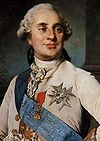 |
23 August 1754, Versailles son of Dauphin Louis and Marie-Josèphe of Saxony Marie-Josèphe of Saxony Maria Josepha of Saxony was a Duchess of Saxony and the Dauphine of France. She became Dauphine at the age of fifteen through her marriage to Louis de France, the son and heir of Louis XV... |
Marie Antoinette of Austria Marie Antoinette Marie Antoinette ; 2 November 1755 – 16 October 1793) was an Archduchess of Austria and the Queen of France and of Navarre. She was the fifteenth and penultimate child of Holy Roman Empress Maria Theresa and Holy Roman Emperor Francis I.... 16 May 1770 4 children |
21 January 1793 Paris aged 38 |
| Louis XVII Louis XVII of France Louis XVII , from birth to 1789 known as Louis-Charles, Duke of Normandy; then from 1789 to 1791 as Louis-Charles, Dauphin of France; and from 1791 to 1793 as Louis-Charles, Prince Royal of France, was the son of King Louis XVI of France and Queen Marie Antoinette... 1793–1795 |
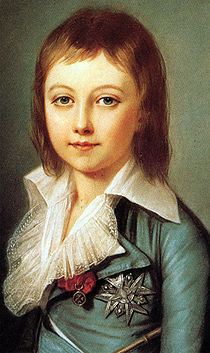 |
27 March 1785, Versailles son of Louis XVI Louis XVI of France Louis XVI was a Bourbon monarch who ruled as King of France and Navarre until 1791, and then as King of the French from 1791 to 1792, before being executed in 1793.... and Marie Antoinette of Austria Marie Antoinette Marie Antoinette ; 2 November 1755 – 16 October 1793) was an Archduchess of Austria and the Queen of France and of Navarre. She was the fifteenth and penultimate child of Holy Roman Empress Maria Theresa and Holy Roman Emperor Francis I.... |
never married | 8 June 1795 Paris aged 10 |
| Louis XVIII Louis XVIII of France Louis XVIII , known as "the Unavoidable", was King of France and of Navarre from 1814 to 1824, omitting the Hundred Days in 1815... 1795–1824 |
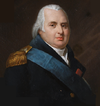 |
17 November 1755, Versailles son of Dauphin Louis and Marie-Josèphe of Saxony Marie-Josèphe of Saxony Maria Josepha of Saxony was a Duchess of Saxony and the Dauphine of France. She became Dauphine at the age of fifteen through her marriage to Louis de France, the son and heir of Louis XV... |
Marie Josephine Louise of Savoy Marie Josephine Louise of Savoy Marie Joséphine of Savoy was the wife of the future King Louis XVIII of France... 14 May 1771 No children |
16 September 1824 Paris aged 68 |
| Charles X Charles X of France Charles X was known for most of his life as the Comte d'Artois before he reigned as King of France and of Navarre from 16 September 1824 until 2 August 1830. A younger brother to Kings Louis XVI and Louis XVIII, he supported the latter in exile and eventually succeeded him... 1824–1836 |
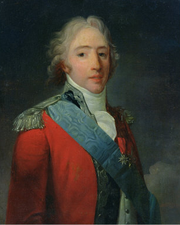 |
9 October 1757, Versailles son of Dauphin Louis and Marie-Josèphe of Saxony Marie-Josèphe of Saxony Maria Josepha of Saxony was a Duchess of Saxony and the Dauphine of France. She became Dauphine at the age of fifteen through her marriage to Louis de France, the son and heir of Louis XV... |
Marie Thérèse of Savoy 16 November 1773 3 children |
6 November 1836 Gorizia Gorizia Gorizia is a town and comune in northeastern Italy, in the autonomous region of Friuli Venezia Giulia. It is located at the foot of the Julian Alps, bordering Slovenia. It is the capital of the Province of Gorizia, and it is a local center of tourism, industry, and commerce. Since 1947, a twin... aged 79 |
| Louis-Antoine, Duke of Angoulême Louis-Antoine, Duke of Angouleme Louis Antoine of France, Duke of Angoulême was the eldest son of Charles X of France and, from 1824 to 1836, the last Dauphin of France... (Louis XIX) 1836–1844 |
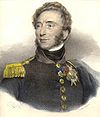 |
6 August 1775, Versailles son of Charles X Charles X of France Charles X was known for most of his life as the Comte d'Artois before he reigned as King of France and of Navarre from 16 September 1824 until 2 August 1830. A younger brother to Kings Louis XVI and Louis XVIII, he supported the latter in exile and eventually succeeded him... and Marie Thérèse of Savoy |
Marie-Thérèse-Charlotte of France Marie-Thérèse-Charlotte of France Marie Thérèse de France was the eldest child of King Louis XVI of France and his wife, Queen Marie Antoinette... June 1799 No children |
3 June 1844 Gorizia Gorizia Gorizia is a town and comune in northeastern Italy, in the autonomous region of Friuli Venezia Giulia. It is located at the foot of the Julian Alps, bordering Slovenia. It is the capital of the Province of Gorizia, and it is a local center of tourism, industry, and commerce. Since 1947, a twin... aged 68 |
| Henri, comte de Chambord Henri, comte de Chambord Henri, comte de Chambord was disputedly King of France from 2 to 9 August 1830 as Henry V, although he was never officially proclaimed as such... (Henry V) 1844–1883 |
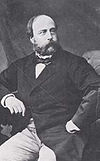 |
29 September 1820, Paris son of Charles Ferdinand, Duke of Berry and Caroline Ferdinande Louise of Two Sicilies |
Marie Thérèse of Austria-Este Archduchess Maria Theresa of Austria-Este (1817–1886) Archduchess Maria Theresa of Austria-Este was a member of the House of Austria-Este and Archduchess and Princess of Austria, Princess of Hungary, Bohemia, and Modena by birth. Through her marriage to Henri, comte de Chambord, Maria Theresa was also a member of the House of Bourbon... November 1846 No children |
24 August 1883 Gorizia Gorizia Gorizia is a town and comune in northeastern Italy, in the autonomous region of Friuli Venezia Giulia. It is located at the foot of the Julian Alps, bordering Slovenia. It is the capital of the Province of Gorizia, and it is a local center of tourism, industry, and commerce. Since 1947, a twin... aged 63 |
List of Legitimist-Anjou claimants to the French throne since 1883
Those Legitimists who did not accept the Orléanist line as the successors of Chambord argued that the renunciation of the French throne by Philip V of SpainPhilip V of Spain
Philip V was King of Spain from 15 November 1700 to 15 January 1724, when he abdicated in favor of his son Louis, and from 6 September 1724, when he assumed the throne again upon his son's death, to his death.Before his reign, Philip occupied an exalted place in the royal family of France as a...
, second grandson of Louis XIV, was invalid, and that in 1883 (when Chambord died childless) the throne had passed to Philip V's male heirs. This line had also lost the Spanish throne in favor of the non-Salic
Salic law
Salic law was a body of traditional law codified for governing the Salian Franks in the early Middle Ages during the reign of King Clovis I in the 6th century...
heiress Isabella II
Isabella II of Spain
Isabella II was the only female monarch of Spain in modern times. She came to the throne as an infant, but her succession was disputed by the Carlists, who refused to recognise a female sovereign, leading to the Carlist Wars. After a troubled reign, she was deposed in the Glorious Revolution of...
, and were known as the Carlist pretenders in Spain. The French claim was reunited with that of the Isabelline Spanish line when the Carlist branch died out in 1936, though Alfonso XIII of Spain
Alfonso XIII of Spain
Alfonso XIII was King of Spain from 1886 until 1931. His mother, Maria Christina of Austria, was appointed regent during his minority...
had by that time been dethroned by the Second Spanish Republic
Second Spanish Republic
The Second Spanish Republic was the government of Spain between April 14 1931, and its destruction by a military rebellion, led by General Francisco Franco....
. The French and Spanish claims separated again at Alfonso's death, as his eldest surviving son Infante Jaime
Infante Jaime, Duke of Segovia
Infante Jaime of Spain, Duke of Segovia, Grandee of Spain , was the second son of King Alfonso XIII of Spain and his wife Princess Victoria Eugenie of Battenberg...
renounced his claim to the Spanish throne due to physical disability and, some years later, asserted a claim to the French succession based on Legitimist principles. The present French Legitimist claimant is descended from Jaime, while the present King of Spain is descended from his younger brother, Don Juan.
| Claimant | | Portrait | Birth | | Marriages | | Death |
|---|---|---|---|---|
| Juan, Count of Montizón Juan, Count of Montizón Don Juan Carlos María Isidro de Borbón, Count of Montizón was the Carlist claimant to the throne of Spain from 1860 to 1868, and the Legitimist claimant to the throne of France from 1883 to 1887.- Youth and marriage :... (Jean III) 1883-1887 |
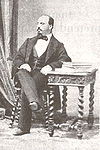 |
15 May 1822, Aranjuez son of Carlos of Spain, Count of Molina and Maria Francisca of Portugal |
Beatrix of Austria-Este Archduchess Maria Beatrix of Austria-Este Maria Beatrix of Austria-Este was a member of the House of Austria-Este and Archduchess and Princess of Austria, Princess of Hungary, Bohemia, and Modena by birth. Daughter of Francis IV of Modena and his niece, Beatrix II of Modena... 6 February 1847 2 children |
21 November 1887 Hove Hove Hove is a town on the south coast of England, immediately to the west of its larger neighbour Brighton, with which it forms the unitary authority Brighton and Hove. It forms a single conurbation together with Brighton and some smaller towns and villages running along the coast... aged 65 |
| Carlos, Duke of Madrid Carlos, Duke of Madrid Infante Carlos María de los Dolores Juan Isidro José Francisco Quirin Antonio Miguel Gabriel Rafael de Borbón y Austria-Este, Duke of Madrid was the senior member of the House of Bourbon from 1887 until his death... (Charles XI) 1887–1909 |
.jpg) |
30 March 1848, Ljubljana Ljubljana Ljubljana is the capital of Slovenia and its largest city. It is the centre of the City Municipality of Ljubljana. It is located in the centre of the country in the Ljubljana Basin, and is a mid-sized city of some 270,000 inhabitants... son of Juan, Count of Montizón Juan, Count of Montizón Don Juan Carlos María Isidro de Borbón, Count of Montizón was the Carlist claimant to the throne of Spain from 1860 to 1868, and the Legitimist claimant to the throne of France from 1883 to 1887.- Youth and marriage :... and Beatrix of Austria-Este |
Margarita of Bourbon-Parma Princess Margherita of Bourbon-Parma Princess Margherita of Bourbon-Parma was the eldest child and daughter of Charles III, Duke of Parma and Princess Louise Marie Thérèse of France, the eldest daughter of Charles Ferdinand, Duke of Berry and Princess Caroline Ferdinande Louise of the Two Sicilies... 4 February 1867 5 children |
18 July 1909 Varese Varese Varese is a town and comune in north-western Lombardy, northern Italy, 55 km north of Milan.It is the capital of the Province of Varese. The hinterland or urban part of the city is called Varesotto.- Geography :... aged 61 |
| Jaime, Duke of Madrid (Jacques I) 1909–1931 |
 |
27 June 1870, Vevey Vevey Vevey is a town in Switzerland in the canton Vaud, on the north shore of Lake Geneva, near Lausanne.It was the seat of the district of the same name until 2006, and is now part of the Riviera-Pays-d'Enhaut District... son of Carlos, Duke of Madrid Carlos, Duke of Madrid Infante Carlos María de los Dolores Juan Isidro José Francisco Quirin Antonio Miguel Gabriel Rafael de Borbón y Austria-Este, Duke of Madrid was the senior member of the House of Bourbon from 1887 until his death... and Margarita of Bourbon-Parma |
never married | 2 October 1931 París Paris Paris is the capital and largest city in France, situated on the river Seine, in northern France, at the heart of the Île-de-France region... aged 61 |
| Alfonso Carlos of Bourbon, Duke of San Jaime (Charles XII) 1931–1936 |
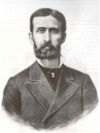 |
12 September 1849 London son of Juan, Count of Montizón Juan, Count of Montizón Don Juan Carlos María Isidro de Borbón, Count of Montizón was the Carlist claimant to the throne of Spain from 1860 to 1868, and the Legitimist claimant to the throne of France from 1883 to 1887.- Youth and marriage :... and Beatrix of Austria-Este |
Maria das Neves of Portugal Infanta Maria das Neves of Portugal Infanta Maria das Neves of Portugal was the eldest child and daughter of exiled Miguel of Portugal and his wife Adelaide of Löwenstein-Wertheim-Rosenberg... 26 April 1871 1 child |
29 September 1936 Vienna Vienna Vienna is the capital and largest city of the Republic of Austria and one of the nine states of Austria. Vienna is Austria's primary city, with a population of about 1.723 million , and is by far the largest city in Austria, as well as its cultural, economic, and political centre... aged 87 |
| Alfonso XIII of Spain Alfonso XIII of Spain Alfonso XIII was King of Spain from 1886 until 1931. His mother, Maria Christina of Austria, was appointed regent during his minority... (Alphonse I) 1936–1941 |
17 May 1886, Madrid son of Alfonso XII of Spain Alfonso XII of Spain Alfonso XII was king of Spain, reigning from 1874 to 1885, after a coup d'état restored the monarchy and ended the ephemeral First Spanish Republic.-Early life and paternity:Alfonso was the son of Queen Isabella II of Spain, and... and Maria Christina of Austria Maria Christina of Austria Maria Christina of Austria was Queen consort of Spain as the second wife of King Alfonso XII of Spain... |
Victoria Eugenie of Battenberg 31 May 1906 7 children |
28 February 1941 Rome aged 54 |
|
| Infante Jaime, Duke of Segovia Infante Jaime, Duke of Segovia Infante Jaime of Spain, Duke of Segovia, Grandee of Spain , was the second son of King Alfonso XIII of Spain and his wife Princess Victoria Eugenie of Battenberg... (Henri VI) 1941–1975 |
23 June 1908, Segovia Segovia Segovia is a city in Spain, the capital of Segovia Province in the autonomous community of Castile and León. It is situated north of Madrid, 30 minutes by high speed train. The municipality counts some 55,500 inhabitants.-Etymology:... son of Alfonso XIII of Spain Alfonso XIII of Spain Alfonso XIII was King of Spain from 1886 until 1931. His mother, Maria Christina of Austria, was appointed regent during his minority... and Victoria Eugenie of Battenberg |
first marriage Emmanuelle de Dampierre 4 March 1935 Rome (divorced 6 May 1947) 2 children - - - - - - - - - - - - - - second marriage (civil only, not recognized by the Church) Charlotte Luise Auguste Tiedemann 3 August 1949 Vienna Vienna Vienna is the capital and largest city of the Republic of Austria and one of the nine states of Austria. Vienna is Austria's primary city, with a population of about 1.723 million , and is by far the largest city in Austria, as well as its cultural, economic, and political centre... no children |
20 March 1975 St. Gallen St. Gallen St. Gallen is the capital of the canton of St. Gallen in Switzerland. It evolved from the hermitage of Saint Gall, founded in the 7th century. Today, it is a large urban agglomeration and represents the center of eastern Switzerland. The town mainly relies on the service sector for its economic... aged 67 |
|
| Alfonso, Duke of Anjou and Cádiz Alfonso, Duke of Anjou and Cádiz Alfonso, Duke of Anjou and Duke of Cádiz, Grandee of Spain was a grandson of King Alfonso XIII of Spain and a Legitimist claimant to the throne of France.-Life:Alfonso was born in the Clinica Santa Anna in Rome, the elder son of Infante... (Alphonse II) 1975–1989 |
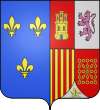 |
20 April 1936, Rome son of Jaime, Duke of Segovia Infante Jaime, Duke of Segovia Infante Jaime of Spain, Duke of Segovia, Grandee of Spain , was the second son of King Alfonso XIII of Spain and his wife Princess Victoria Eugenie of Battenberg... and Emmanuelle de Dampierre |
María del Carmen Martínez-Bordiú y Franco María del Carmen Martínez-Bordiú y Franco María del Carmen Martínez-Bordiú y Franco is a Spanish aristocrat and social figure. Under Spanish law since 2006 she precedes her younger brother as heir to her mother's dukedom, and is eligible to be succeeded by and/or to cede that grandeza to her descendants.-Birth and youth:She was born in... 8 March 1972 Royal Palace of El Pardo (divorced 1982/annulled 1986) 2 children |
30 January 1989 Beaver Creek Beaver Creek, Colorado Beaver Creek is an unincorporated community in Eagle County, Colorado, United States. Beaver Creek is located immediately south of the town of Avon and encompasses the Beaver Creek Resort and adjacent business, lodging, and residential areas. The U.S... aged 53 |
| Louis Alphonse, Duke of Anjou Louis Alphonse, Duke of Anjou Prince Louis Alphonse of Bourbon, Duke of Anjou was not originally among his given names ; born 25 April 1974, Madrid) is a member of the historically royal dynasty of the House of Bourbon, and one of the current pretenders to the defunct crown of France... (Louis XX) 1989–present |
 |
25 April 1974, Madrid son of Alfonso, Duke of Anjou and Cádiz Alfonso, Duke of Anjou and Cádiz Alfonso, Duke of Anjou and Duke of Cádiz, Grandee of Spain was a grandson of King Alfonso XIII of Spain and a Legitimist claimant to the throne of France.-Life:Alfonso was born in the Clinica Santa Anna in Rome, the elder son of Infante... and María del Carmen Martínez-Bordiú y Franco María del Carmen Martínez-Bordiú y Franco María del Carmen Martínez-Bordiú y Franco is a Spanish aristocrat and social figure. Under Spanish law since 2006 she precedes her younger brother as heir to her mother's dukedom, and is eligible to be succeeded by and/or to cede that grandeza to her descendants.-Birth and youth:She was born in... |
María Margarita Vargas Santaella Maria Margarita, Duchess of Anjou Princess Marie Marguerite of Bourbon, Duchess of Anjou is a Venezuelan heiress and wife of Louis Alphonse of Bourbon, Duke of Anjou, who is considered to be the head of the French Royal House making Marie Marguerite the Legitimist titular queen consort of France by royalists who consider the... 5 November 2004 Caracas Caracas Caracas , officially Santiago de León de Caracas, is the capital and largest city of Venezuela; natives or residents are known as Caraquenians in English . It is located in the northern part of the country, following the contours of the narrow Caracas Valley on the Venezuelan coastal mountain range... 3 children |
|
Legitimist-Orléanist claimants to the French throne
In the 1870s the rival Legitimist and OrléanistOrléanist
The Orléanists were a French right-wing/center-right party which arose out of the French Revolution. It governed France 1830-1848 in the "July Monarchy" of king Louis Philippe. It is generally seen as a transitional period dominated by the bourgeoisie and the conservative Orleanist doctrine in...
claimants agreed, for the sake of the French monarchy, to end their rivalry. Philippe d'Orléans, the comte de Paris and grandson of Louis Philippe I, accepted the prior claim to the throne of the comte de Chambord. Chambord, who remained childless, in turn acknowledged that Philippe would claim the right to succeed him as heir and after his death, many Legitimists accepted the descendants of Philippe as the rightful pretender.
According to this point of view, the proper line follows the one above from Louis XVI through Chambord ("Henry V"), but thereafter follows the Orléanist line, from Philippe d'Orléans ("Philippe VII") to the present.
See also
- René RémondRené Rémond-Biography:Born in Lons-le-Saunier, Rémond was the Secretary General of Jeunesses étudiantes Catholiques and a member of the International YCS Center of Documentation and Information in Paris, presently the International Secretariat of International Young Catholic Students The author of books on...
- BonapartismBonapartismBonapartism is often defined as a political expression in the vocabulary of Marxism and Leninism, deriving from the career of Napoleon Bonaparte. Karl Marx was a student of Jacobinism and the French Revolution as well as a contemporary critic of the Second Republic and Second Empire...
- Orleanism
- Ultra-royalistUltra-royalistUltra-Royalists or simply Ultras were a reactionary faction which sat in the French parliament from 1815 to 1830 under the Bourbon Restoration...
s - Bourbon RestorationBourbon RestorationThe Bourbon Restoration is the name given to the period following the successive events of the French Revolution , the end of the First Republic , and then the forcible end of the First French Empire under Napoleon – when a coalition of European powers restored by arms the monarchy to the...
- France in the nineteenth centuryFrance in the nineteenth centuryThe History of France from 1789 to 1914 extends from the French Revolution to World War I and includes:*French Revolution *French First Republic *First French Empire under Napoleon...
- Parti de l'OrdreParti de l'OrdreThe Parti de l'Ordre was a French Orleanist and Legitimist conservative political party that existed during the Second Republic....
- Line of succession to the French throne (Legitimist-Anjou)
- Line of succession to the French throne (Legitimist-Orléanist)Line of succession to the French throne (Orléanist)The Orléanist claimant to the throne of France is Prince Henri, Count of Paris, Duke of France. He is the uncontested heir to the Orléanist position of "King of the French" held by Louis-Philippe, and is also King Charles X's heir as "King of France" if the 1713 Treaty of Utrecht is...

